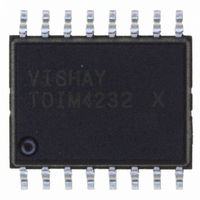TOIM4232-TR3 Vishay, TOIM4232-TR3 Datasheet - Page 9

TOIM4232-TR3
Manufacturer Part Number
TOIM4232-TR3
Description
IC SIR ENDEC IRDA 115.2K 16-SOIC
Manufacturer
Vishay
Type
Infrared Encoder/Decoderr
Datasheet
1.TOIM4232-TR3.pdf
(17 pages)
Specifications of TOIM4232-TR3
Voltage - Supply, Analog
2.7 V ~ 3.6 V
Voltage - Supply, Digital
2.7 V ~ 3.6 V
Mounting Type
Surface Mount
Package / Case
16-SOIC (0.300", 7.5mm Width)
Data Transmission Rate
2.4 Kbits/s to 115.2 Kbits/s
Mounting Style
SMD/SMT
Operating Voltage
2.7 V to 3.6 V
Maximum Operating Temperature
+ 85 C
Minimum Operating Temperature
- 25 C
Ic Function
SIR Endec For IrDA Application
Brief Features
Pulse Shaping Function, Programmable Baud Clock Generator, Low Operating Current
Supply Voltage Range
2.7V To 3.6V
Operating Temperature (min)
-25C
Operating Temperature Classification
Commercial
Operating Temperature (max)
85C
Package Type
SOIC
Rad Hardened
No
Lead Free Status / RoHS Status
Lead free / RoHS Compliant
Applications
-
Lead Free Status / Rohs Status
Compliant
Other names
751-1200-2
Available stocks
Company
Part Number
Manufacturer
Quantity
Price
Company:
Part Number:
TOIM4232-TR3
Manufacturer:
Vishay Semiconductors
Quantity:
135
Company:
Part Number:
TOIM4232-TR3
Manufacturer:
MICREL
Quantity:
442
Part Number:
TOIM4232-TR3
Manufacturer:
VISHAY/威世
Quantity:
20 000
RECOMMENDED SOLDER PROFILES
Solder Profile for Sn/Pb Soldering
Lead (Pb)-free, Recommended Solder Profile
The TOIM4232 is a lead (Pb)-free transceiver and qualified
for lead (Pb)-free processing. For lead (Pb)-free solder paste
like Sn
profiles: Ramp-Soak-Spike (RSS) and Ramp-To-Spike
(RTS). The Ramp-Soak-Spike profile was developed
primarily for reflow ovens heated by infrared radiation. With
widespread use of forced convection reflow ovens the
Ramp-To-Spike profile is used increasingly. Shown below in
figure 2 and 3 are Vishay’s recommended profiles for use
with the TOIM4232 transceivers. For more details please
refer to the application note “SMD Assembly Instructions”.
A ramp-up rate less than 0.9 °C/s is not recommended.
Ramp-up rates faster than 1.3 °C/s could damage an optical
part because the thermal conductivity is less than compared
to a standard IC.
Wave Soldering
For TFDUxxxx and TFBSxxxx transceiver devices and the
TOIM4232, TOIM5232 endecs wave soldering is not
recommended.
Manual Soldering
Manual soldering is the standard method for lab use.
However,
recommended because the risk of damage is highly
dependent on the experience of the operator. Nevertheless,
we added a chapter to the above mentioned application note,
describing manual soldering and desoldering.
Storage
The storage and drying processes for the endec TOIM4232
are equivalent to MSL3.
The data for the drying procedure is given on labels on the
packing and also in the application note “Taping, Labeling,
Storage and Packing”.
Document Number: 82546
Rev. 2.1, 17-Nov-10
Fig. 1 - Recommended Solder Profile for Sn/Pb Soldering
19535
260
240
220
200
180
160
140
120
100
(3.0 - 4.0)
80
60
40
20
0
0
for
Ag
2 to 4 °C/s
50
a
(0.5 - 0.9)
production
100
irdasupportAM@vishay.com, irdasupportAP@vishay.com,
Cu, there are two standard reflow
160 °C max.
240 °C max.
120 to180 s
150
For technical questions within your region, please contact one of the following:
Time/s
2 to 4 °C/s
process
200
90 s max.
10 s max. at 230 °C
SIR Endec for IrDA
250
it
Integrated Interface Circuit
300
cannot
350
be
®
Applications
TFDU Fig3
19532
275
250
225
200
175
150
125
100
280
240
200
160
120
75
50
25
80
40
0
0
0
0
Fig. 2 - Solder Profile, RSS Recommendation
irdasupportEU@vishay.com
2 °C/s to 3 °C/s
50
T ≥ 217 °C for 70 s max.
50
Fig. 3 - RTS Recommendation
T ≥ 255 °C for 10 s....30 s
T
100
peak
1.3 °C/s
Vishay Semiconductors
Peak temperature T
100
90 s to 120 s
Time above 217 °C t ≤ 70 s
Time above 250 °C t ≤ 40 s
= 260 °C max.
150
Time/s
Time/s
150
200
peak
70 s max.
200
30 s max.
< 4 °C/s
TOIM4232
250
= 260 °C
T
www.vishay.com
< 2 °C/s
peak
2 °C/s to 4 °C/s
250
300
= 260 °C
300
350
9












